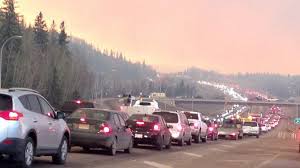
Many sources and eye-witness accounts lay blame to the ongoing extreme forest fires in northern Alberta as an unfortunate natural disaster, an “Act of God” or simply making Mother Nature the villain. We cannot lay blame on Mother Nature for our own inaction or inability to reduce carbon emissions at a pace needed to reverse climactic trends in order to effectively tackle the fates of those directly or indirectly impacted by these disasters.
The mounting evidence of “un”natural disasters in the last decades linked to what climate scientists have associated as more regular extreme occurrances (floods where rainfall becomes extreme, forest fires, droughts and prolonged dry periods) are indeed happening more frequently and with greater ferocity. Climate scientists indicate that the dryness from a lack of rainfall and snow-melt in the soil, this early in the forest fire season, are “likely to have contributed to the Fort McMurray wildfire”. So why is it unreasonable to link the very activity of extracting and burning fossil fuels in the oil sands region, where these fires are taking place, considered provocative and untimely?.. Doubting human-causality from the burning of carbon in our atmosphere is only skirting the issue at hand and anyone responding by cautiously tip-toeing around that connection is simply contradicting the new reality — a hard pill to swallow.
The Fort McMurray fire has tragically forced more than 80,000 people to literally pack up and escape for their lives and is already being described as one of the most devastating — and certainly most expensive — in Alberta’s history. Marc-André Parisien, a research scientist with the Canadian Forest Service in Edmonton, even indicates that the boreal region of Alberta, where Fort McMurray is located, can expect even more intense fires in the coming years.
“We know from looking at weather records from the last 100 years that the fire season is lengthening, and intense fires like this are increasingly common,” says Parisien.

We cannot blame the fleeing victims whose livelihood depend on working in the oil patch nor can we really blame the industry that brought them there to earn money, but we have to come to the realization that we cannot foreseeably carry on back to “normal” and spend billions to rebuild under the same conditions that helped elevate the risk of unnatural disasters in the first place.
Slave Lake, another forest fire in northern Alberta, in 2011, ravaged the township. The fire destroyed roughly one-third of Slave Lake; nearly 400 properties were destroyed and 732 people were left homeless as a result.
Green Party of Canada leader, Ms Elizabeth May, got a taste of public wrath — and even a comment from PM Justin Trudeau — when she stated “Of course” to the question from the media asking if the Fort Mac fires were linked to climate change.”Pointing at any one incident and saying, ‘Well this is because of that,’ is neither helpful nor entirely accurate,” he said. Well, not making the association is even less helpful.
There are those that want to keep undermining the urgency of acting proactively calling environmentalists “carbon nazis” and that attitude to lash out is really unhelpful.
There is a societal need to respond to the victims now — and rightly so, but to really prevent these disasters from happening again and again, we need to reduce our emissions more than just a little, and the sooner, the better.
Ironically, the movement to “keep it in the ground” may have just got what they asked for as a result of the overarching devastation the fires have caused to the already economically crippled oil industry and its infrastructure, but they will undoubtedly expect money from all levels to kick into the rebuilding — an exercise in futility given the lack of money that has gone into public coffers over the years creating the massive debt loads to Albertans in particular. Pure fossilfoolishness.
The oil patch has invested heavily on manipulated information and PR to lessen the focus on their massive emissions and chicken has come home to roost. Oil industry execs and supporting politicians have relentlessly talked about “the social licence to operate”—the general public’s willingness to permit them to cut down then plough under virgin boreal wetlands to spew great clouds of carbon for an ostensibly “greater good” — while avoiding or downplaying the rational science.
For perspective, Fort McMurray was a small speck of a population of barely 1000 in the 1950s.Essential and profitable as it might have been, the oil business has been the black smear on Canada’s international record abroad over the past decade as it became the poster child for Canada’s laggard efforts to combat climate change. In 2008, one environmental group called the oil sands “the most destructive project on earth,”
Perhaps it was, but history will not be kind in a world more focussed on proactively reducing impacts associated with climate change and a scorched industry neck-deep in its own negligence.
Leave a comment